|
1.
CENTRAL/ WEST AFRICA
Steep decline in trade lead to price retreat in West
Africa
The volume of trade continued to decline. Demand from
Asia and Europe was very low and producers in West and
Central Africa were slowing production to even lower
levels than they had previously considered necessary. In
some areas, there were quite large volumes of older logs
that had either been sold off at a low price or converted to
sawn lumber. Orders were available for fresh logs but
limited to very restricted species and for better qualities
only. Prices for the premium species such as sapele had
fallen again and even sipo had been marked down.
Demand for okoume logs was also low and prices tended
to be weak with an overstock of older logs still to be sold.
Prices for many species were unchanged due to the
absence of demand.
Buyers were delaying shipments against existing contracts
which were causing a build up of both logs and sawn
lumber in the export storage yards and at mills.
There were predictions as to when an improvement in
demand might occur and, with construction activity in
Europe rapidly scaling down, there was consensus that
poor market conditions would continue possibly through
to the end of the year.
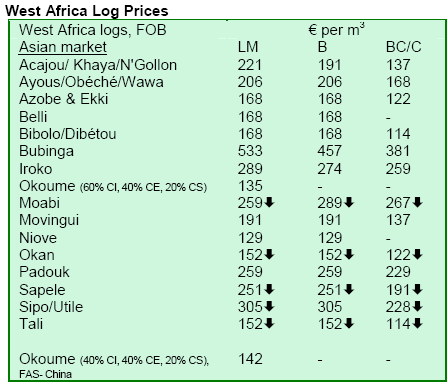
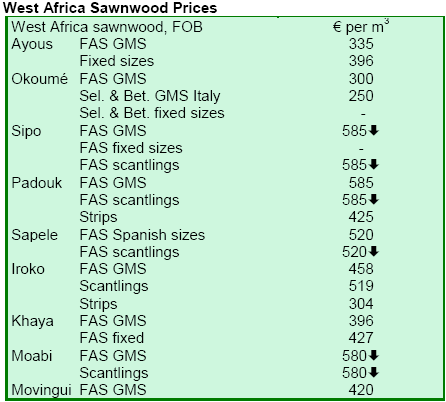
2. GHANA
Minister inaugurates wood cluster initiative
The Deputy Minister of Lands, Forestry and Mines, Mr.
Andrew Agyei Yeboah, has inaugurated a Wood Cluster
Initiative Secretariat at the Wood Industry Training Centre
(WITC) in Akyiakrom near Kumasi, Ghana. The
Secretariat is expected to create a platform for
businessmen, institutions and government agencies to
promote innovation, value-adding and competitiveness for
wood products in the country. During the launch, Mr.
Yeboah said there was the need to add value to wood
products to rehabilitate degraded forests in the country.
Prior to the inauguration, a three-day workshop on wood
industry was held at the WITC in Kumasi. More than 40
representatives from the wood industry, academic
institutions and government agencies participated in the
seminar, with the objective of developing a vibrant and
globally competitive wood industry in the Kumasi
metropolis. The participants stressed the need to address
weaknesses in the industry¡¯s use of waste, bush cut
practices, preservation, and drying of timber and lack of
product standards.
TIDD reports drop in wood exports during first quarter
2008
Timber and wood products export statistics released by the
Timber Industry Development Division (TIDD) of the
Forestry Commission for the period January to March
2008 registered declines of 0.5% and 4.3% in volume (m³)
and value (EUR), respectively, compared with figures
recorded for the same period in 2007. The country earned
EUR46.04 million from the total exports of 136,150m³ for
the period under review.
The low volume exports for the period under review
compared to the same period in 2007 could be attributed to
late signing of contracts after the Christmas and New Year
holidays. The table below shows comparative export
statistics for the period under review for both 2008 and
2007.
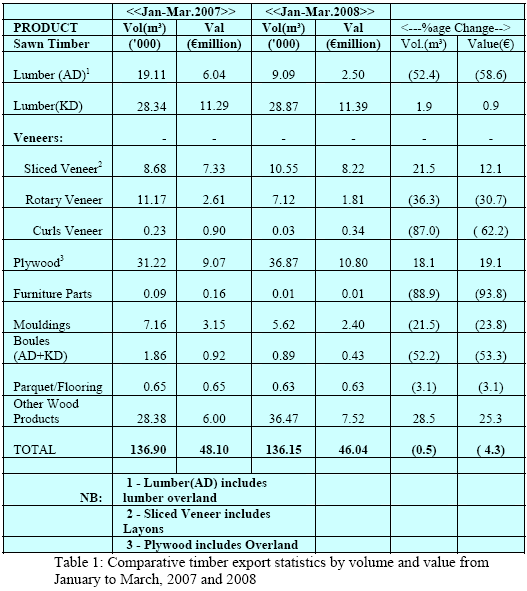
Kiln dried lumber exported during the period was 28,870
m³. This represented a 1.9% increase in volume compared
to the same period in 2007. Revenue from lumber (KD)
increased marginally by 0.9% to EUR11.39 million. For
the same period, the total volume (8,090 m³) of air-dried
lumber (including overland exports) registered a 52.4%
drop in volume compared to the previous year. The
volume represented 6.7% of the overall total exports for
the period. Total earnings from lumber (AD) were EUR
2.5 million, a significant drop of 58.6%.
Plywood exports for the year under review was 18.1%
higher than in 2007, registering a total volume 36,870 m³
valued at EUR10.80 million. The volume of plywood
exports represented 27.12% of total wood exports for the
period. Total exports from Naja David Veneer & Plywood,
John Bitar & Co. Ltd and Ghana Primewood accounted for
71.6% of total plywood exports. The main species of
export were ceiba, chenchen and mahogany.
For the period, sliced veneer export was 10,550 m³
compared to 8,860 m³ registered in 2007. This constituted
21.5% and 12.1% of gains in volume and value,
respectively. The volume of rotary veneer dipped 36.2% in
2008 to 7,120 m³ valued at EUR1.8 million.
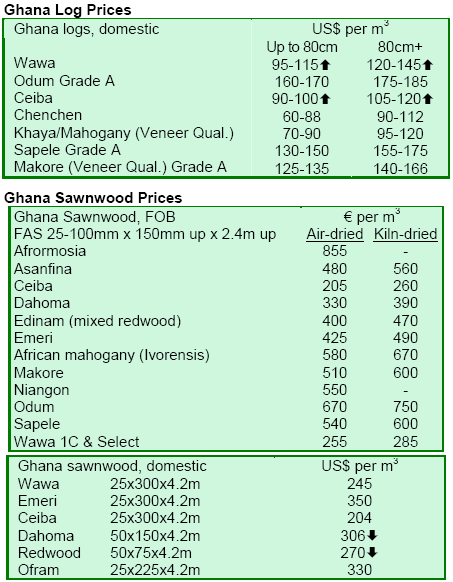
3.
MALAYSIA
FELDA to establish oil palm plantations in the Amazon
The Star Online reported on FELDA¡¯s (Malaysia¡¯s Land
Development Authority) plans to establish 100,000 ha oil
palm plantations in Manaus and Tefe near the Amazon
River in Brazil. About 3,000 to 5,000 ha would be planted
per year, with initial planting in Tefe. The project is a joint
venture, with FELDA holding 70% of the equity and
Brazil¡¯s Brasplama holding the remaining 30%.
Under the plans, FELDA hopes to launch local projects
offering training courses for settlers and their families in
the plantations. Malaysian Deputy Prime Minister Datuk
Seri Najib Tun Razak also said that FELDA had other
projects in the pipeline, including oil palm plantation
ventures in PNG (105,000 ha) and Acheh (45,000 ha) and
a 20,000 ha nursery in Kalimantan.
SFD issues certificate for exemplary RIL
TTJ said an Exemplary Reduced Impact Logging (RIL)
Certificate was issued by the Sabah Forestry Department
(SFD) to the Malaysian firm Hormat Jadi Sdn Bhd for its
strong performance in sustainable logging operations.
During the period September 2006 to December 2007,
Hormat Jadi was reported to have produced 68,000 pieces
of tropical logs (290,000 m³) using RIL techniques. SFD
director Datuk Sam Mannan said Hormat Jadi was the
only company to have produced this amount of tropical
timber in a short time without compromising RIL and
environmental standards.
KL to host Woodtech Malaysia 2008
Bernama News indicated Kuala Lumpur would host the
24-28 September 2008 Aseanwood-Woodtech Malaysia
(WTM 2008) exhibition, where China would have the
largest pavilion. Various industry representatives from the
woodworking machinery, timber processing, forestry
management, furniture manufacturing and supplies sectors
were expected to attend the event.
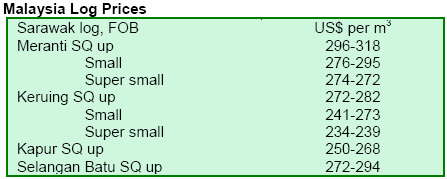
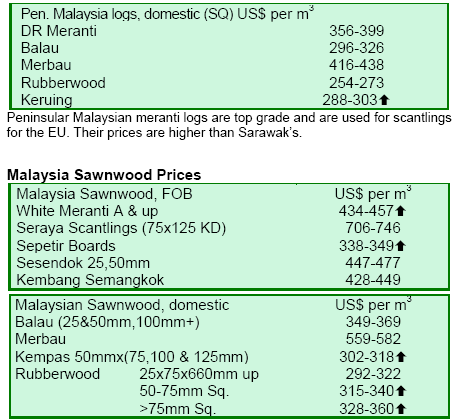
4.
INDONESIA
EPA may not benefit timber producers
As of 1 July 2008, the economic partnership agreement
(EPA) signed by Indonesia and Japan took effect, reported
Antara News. Former Prime Minister Shinzo Abe and
Indonesian President Susilo Bambang Yudhoyono signed
the agreement before Abe¡¯s resignation in September
2007. The agreement, which is aimed at promoting trade
and investment between the countries by reducing tariff
barriers and building capacity, is hoped to serve as a
model for world economic cooperation.
Under the agreement, Japan is exempted from 93% of
Indonesia¡¯s 11,163 import duties, although Indonesia
could still face non-tariff barriers to trade with Japan.
Indonesia¡¯s agricultural and timber products would face
non-tariff and market-access barriers in Japan due to
quality standards. As a result, Indonesian Industry
Minister Fahmi Idris said Japan should invest more in
Indonesia¡¯s manufacturing industry.
According to Antara, Indonesia exported commodities
worth USD23.6 billion in 2007. The value of the two
countries¡¯ trade has increased over the last four years, with
the value of the two countries¡¯ bilateral trade reaching
USD30.1 billion in 2007.
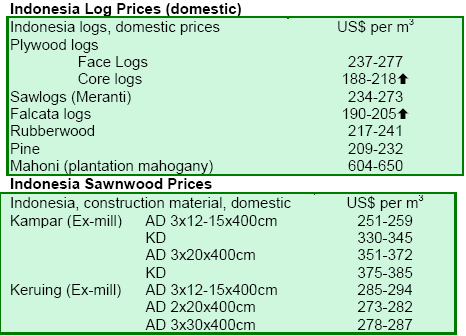
5.
MYANMAR
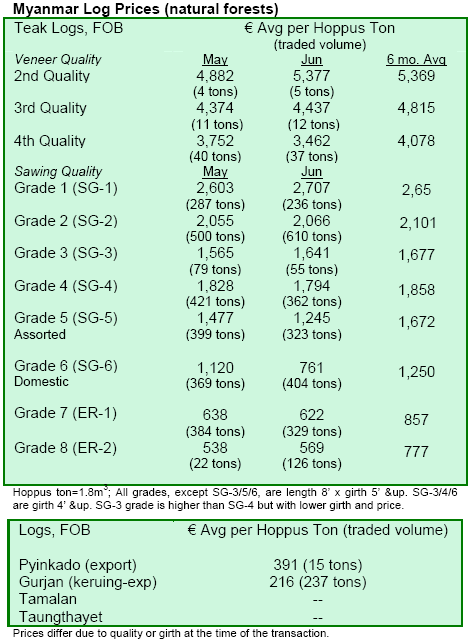
6.
BRAZIL
Amazon deforestation rate recedes in May 2008
Reports from Folha de São Paulo indicated the
deforestation rate in the Amazon decreased in May 2008
by 26% from the same month in 2007. The information
was based on information from the satellite forest
monitoring system (SAD) in Brazil, which also showed
deforestation was 7% for the period of August 2007 to
April 2008. This was equivalent to 4,142 km² of
deforested areas and 2.5 times the area of São Paulo city.
In 2008, 61% of deforestation was concentrated in 36
municipalities of Brazil that were the main targets of
government control actions. This was equivalent to 294
km² of deforested area. The state of Mato Grosso
accounted for 48% of all deforested areas detected by
SAD during 2007-2008, despite the overall deforestation
rate falling 16% compared to the period during 2006-2007.
Major actions have been taken to stop deforestation
state of Mato Grosso since February 2008, with
initiatives launched by the Federal Government.
Nevertheless, a fierce debate over the statistics on
deforestation has been going on between state government
representatives and the Ministry of Environment.
Consumption from Latin American countries sustains
Brazilian furniture exports
Jornal do Com:¦rcio and Remade reported that furniture
exports of the Southern state of Rio Grande do Sol showed
positive net sales during the first five months of the year.
Latin American commercial partners helped post gains of
4.1% from January to May 2008, compared to the same
period in 2007. Latin American countries represent onethird
of the demand for Brazilian furniture. Revenues were
USD112.6 million, up from USD108.2 million in the same
period of 2007.
Furniture imports of Venezuela were high during the
period, according to the Association of Furniture
Producers of Rio Grande do Sul state (MOVERGS). The
country purchased 318% more in the period January to
May 2008, with the total amount of exports to Venezuela
reaching USD1.3 million from January to May 2007, but
increased to USD5.2 million during the same period in
2008. Venezuela was responsible for 4.6% of Rio Grande
dol Sul furniture exports from January to May 2008.
Medium Density Fiberboard (MDF) and Medium Density
Particleboard (MDP) represented 80% of outputs from the
Rio Grande do Sul state. The proximity of Latin American
markets enhanced the competitiveness of furniture exports
from Rio Grande do Sol vis-:∴-vis the Asian competitors,
which suffered logistical constraints such as higher freight
costs. The unfavorable exchange rate of the Brazilian Real
to the US Dollar was also a factor for the weakening
overall furniture exports.
Paran:¢ focuses on Middle East and N. Africa to boost
exports of solidwood products
Arab countries have come under increasing focus by the
state of Paran:¢, one of the largest Brazilian producers and
exporters in the solidwood industry, said the Federation of
State Industries of Paran:¢ (FIEP). Total Brazilian exports
of plywood, sawnwood, doors, frames, particleboard and
MDF to the Middle East and North Africa increased
59.5% between 2006 and 2007. Exports from Paran:¢ alone
jumped 68.6%. In 2006, Paran:¢ traded the equivalent of
USD22.6 million (60% of the total Brazilian exports by
the forest-related industry). In 2007, Paran:¢ exports were
USD38.1 million, 63.2% of Brazil¡¯s total exports.
According to the Brazilian Association for Mechanically
Processed Timber (ABIMCI), the quality of Brazilian
products and Brazil¡¯s sound business relationships with
Arabic countries had facilitated exports. In 2006, the
Middle East and North African markets accounted for
USD37.8 million of export revenues which further rose to
USD 60.3 million in 2007. The markets in Arab countries
had been expanding due to the countries¡¯ growing
economies. Chinese, Indian and Indonesian producers
have an advantage over Brazilian producers due to
logistical reasons. In addition to their closer location,
exchange rates have made Brazilian products less
competitive in the Middle East and North African markets
resulting in reduced revenue from solidwood products.
Although the Middle East is quite far from Brazil, North
African countries are not as distant. In 2007, Morocco was
the largest consumer of Brazilian plywood, sawnwood,
doors, frames, particleboard and MDF accounting for
USD21 million of exports by value. Exports to Saudi
Arabia were USD11.2 million, and those to the United
Arab Emirates were USD10.1 million.
Paran:¢ is a strong exporting state within Brazil. The state
exported USD1.49 billion in 2007, USD1.03 billion of
which consisted of wood-related products. The state of
Paran:¢ is the second largest exporting state after São Paulo
and followed by Santa Catarina. The forest-based industry
involves not only wood and furniture but also pulp and
paper. Pine plywood was the top export product from
Paran:¢, with exports rising 70% from January to March
2008 worth USD115.5 million. Pine sawnwood was the
second most exported product, with USD131.8 million
exported in 2006 and USD111.8 million in 2007.
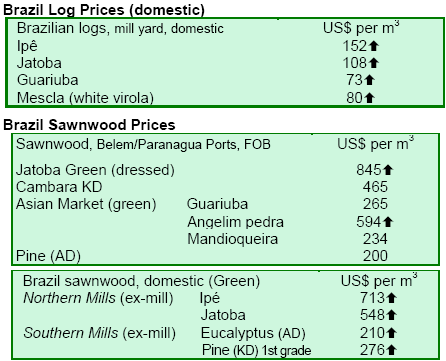
7.
PERU
Changes to Peru forest law encourage forest planting
and reforestation
According to the Decree N¡ã1090, which makes changes to
Peru¡¯s forest law, the Agriculture Ministry is designated as
the national authority in charge of the design, execution,
supervision and evaluation of forest policy. Under the
previous legislative actions, the Agriculture Ministry was
the primary body that promoted the sustained use and the
conservation of forest resources and wild fauna, while
the National Institute of Natural Resources (IRENA) was
in charge of forest management in Peru.
The new Decree also requires national, regional and local
development programs to incorporate planting and
replanting forests as important activities to stimulate
industrial optimization of species such as palmetto, the
rubber tree, bamboo, chestnut, and camu camu, among
others. The law provides for the Agriculture Ministry to
also reward activities that generate more aggregated value
and promote the conservation of biological diversity.
CITES and ITTO assist Peru in strengthening forest law
Representatives from the Secretariat of the Convention on
International Trade in Endangered Species of Wild Flora
and Fauna (CITES) and ITTO visited Peru to assist with
preparations for tighter control on wood trade. The
purpose of the visit was to design legal measures for the
country to help improve management techniques of wood
products listed in CITES Appendices. During the visit,
CITES and ITTO representatives meet with staff of
INRENA and La Molina National Agrarian University as
well as representatives from the wood industry, nongovernmental
organizations (NGOs) and Indian
communities. CITES and ITTO representatives will
continue to work with Peruvian authorities to adjust
CITES-related enforcement measures to ensure adequate
prevention measures against the illegal trafficking of
CITES-listed timber.
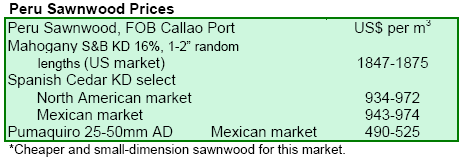

8. BOLIVIA
Bolivia¡¯s MIPYMES play significant role in wood
manufacturing
According to a study on micro, small and medium-sized
companies (MIPYMES) conducted by the Bolivian
Institute of Foreign Commerce (IBCE), Bolivian
MIPYMES exported more than USD30 million worth of
wood products during 2006. Of the total MIPYMES,
medium-sized companies made up 82%, small-sized
companies represented 12% and micro-sized companies
1%.
The total value of exports of the 800 companies analyzed
in the study were USD71.75 million in 2006, with exports
of wood manufacturing sector MIPYMES representing
42.10% of this value. MIPYMES¡¯ exports exceeded that
of the textiles and clothing industry and leather
manufacturers. Santa Cruz, La Paz, Cochabamba and the
city of El Alto were the main exporting centers in the
country, accounting for 88.3% of total MIPYMES.
The Chamber of Bolivian Forestry (CFB) noted that the
study showed the vital social and economic roles played
by MIPYMES forest-related industries in the country. It
also showed how the application of SFM in Bolivia had
helped boost exports and promoted SFM at the global
level.
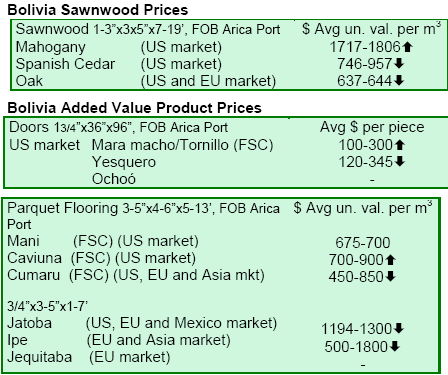
9. MEXICO
More than 9 million trees planted in Mexico
The National Forestry Agency CONAFOR reported that
9.34 million trees were planted on 5 July 2008 by over
507,000 people during a tree planting event. The Secretary
of Environment and Natural Resources, Juan Elvira
Quesada, said the event lasted 14 hours with 31 Mexican
states participating. Of the total number of trees planted,
71% were in rural areas, while 29% were in urban areas.
The states of Chiapas and Puebla recorded the highest
numbers of trees planted. Pine, cedro and mesquite were
the most popular tree species planted.
10.
GUYANA
Guyana continues to gain from positive market trends
Log prices for purpleheart increased 30% over the
previous fortnight and had shown consistently steady
prices over the past five months. Prices of greenheart logs
meanwhile, remained steady with USD120 per m3 seen as
the lower price range over the past few fortnights.
Purpleheart log prices increased to USD235 per m3 as the
upper range and presents encouraging news for one of
Guyana¡¯s most prime species of hardwood.
Guyana¡¯s export volume of undressed lumber had also
reached the highest level of any fortnight in the year.
Also, dressed lumber continued to maintain its market
share. Dressed lumber prices reached a high of USD1,350
for greenheart, reflecting an 87% increase over the
previous fortnight¡¯s upper price. Purpleheart showed
consistent performance in the export market from
USD1,100 as the upper range in the previous fortnight and
moving to USD1,150 over the last fortnight. Demand
remains steady in most markets for this product.
Meanwhile, average price paid for roundwood showed
some improvement over the previous fortnight by a 56%;
this was mainly due to the higher price being paid for
fencing post by Martinique.
Guyana workshop helps participants apply ITTO C&I
In keeping with Guyana¡¯s commitment to utilizing its
forests sustainably, Guyana hosted a national workshop on
revised ITTO Criteria and Indicators (C&I), which was
held from 23-26 June 2008 in Georgetown, Guyana (see
TTM 13:12). Representatives from various stakeholder
groups made presentations on implementing forest
management policies in Guyana, applying ITTO C & Is at
the community level, conducting RIL training, emerging
challenges posed by forest certification and enhancing
legality in forest activities in Guyana. The four-day
session also included several working group activities and
a field visit to a forest concession.
Presentations made by community groups, the private
sector and representatives of the host organization, the
Guyana Forestry Commission, emphasized some of the
major milestones and challenges in Guyana¡¯s forestry
sector. Some of these discussions took place during a field
trip taken to a Demerara Timbers Ltd. concession. The
field trip provided the practical experience needed to apply
ITTO C & Is on the ground. The workshop provided an
opportunity for the participants to review the revised ITTO
C & Is and test their applicability, and to receive training
within the Guyana context. Based on the wide spectrum of
discussion areas and activities, the workshop also
succeeded in identifying the strengths and weaknesses in
Guyana¡¯s application and reporting of ITTO C&Is.


|